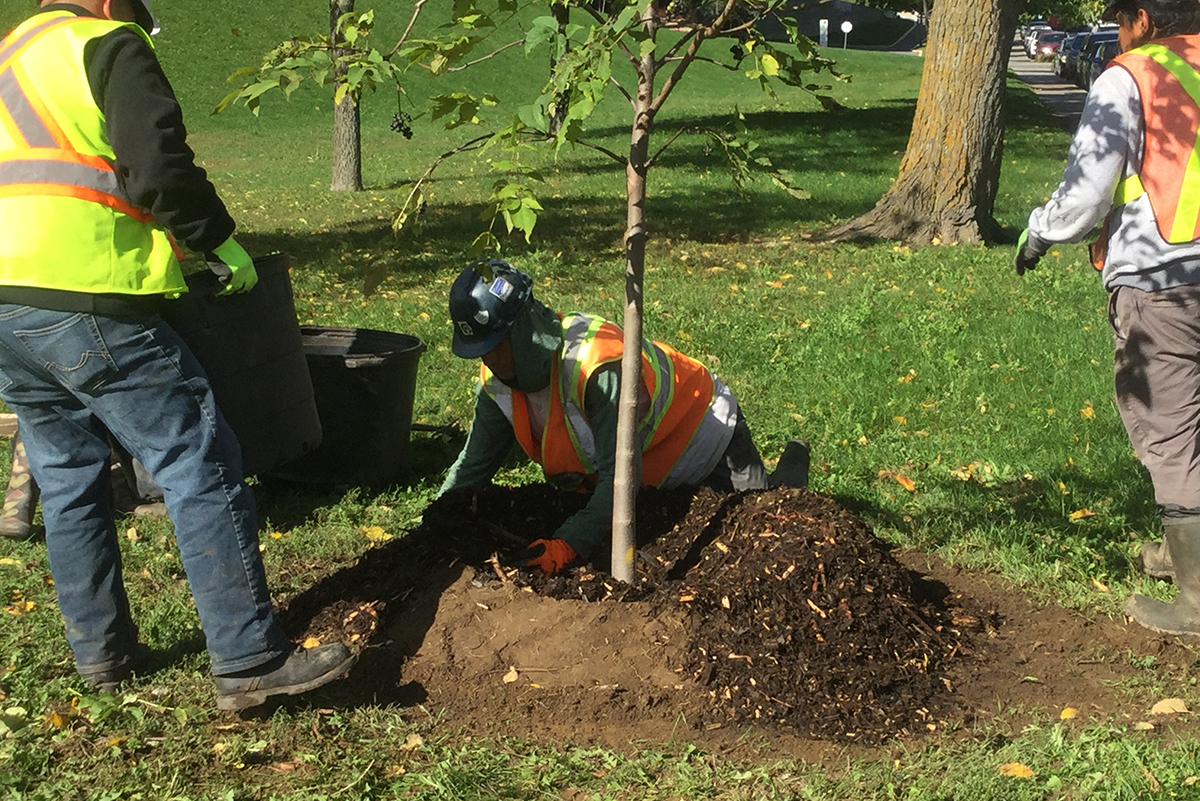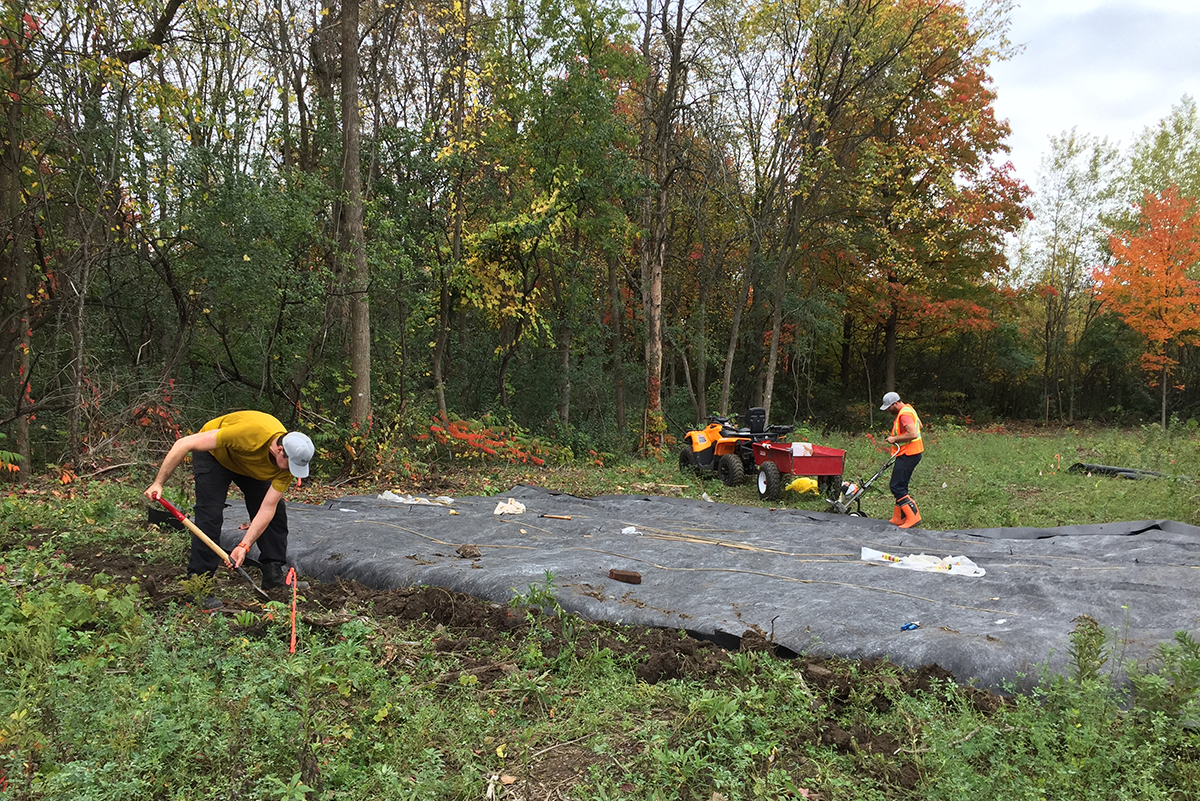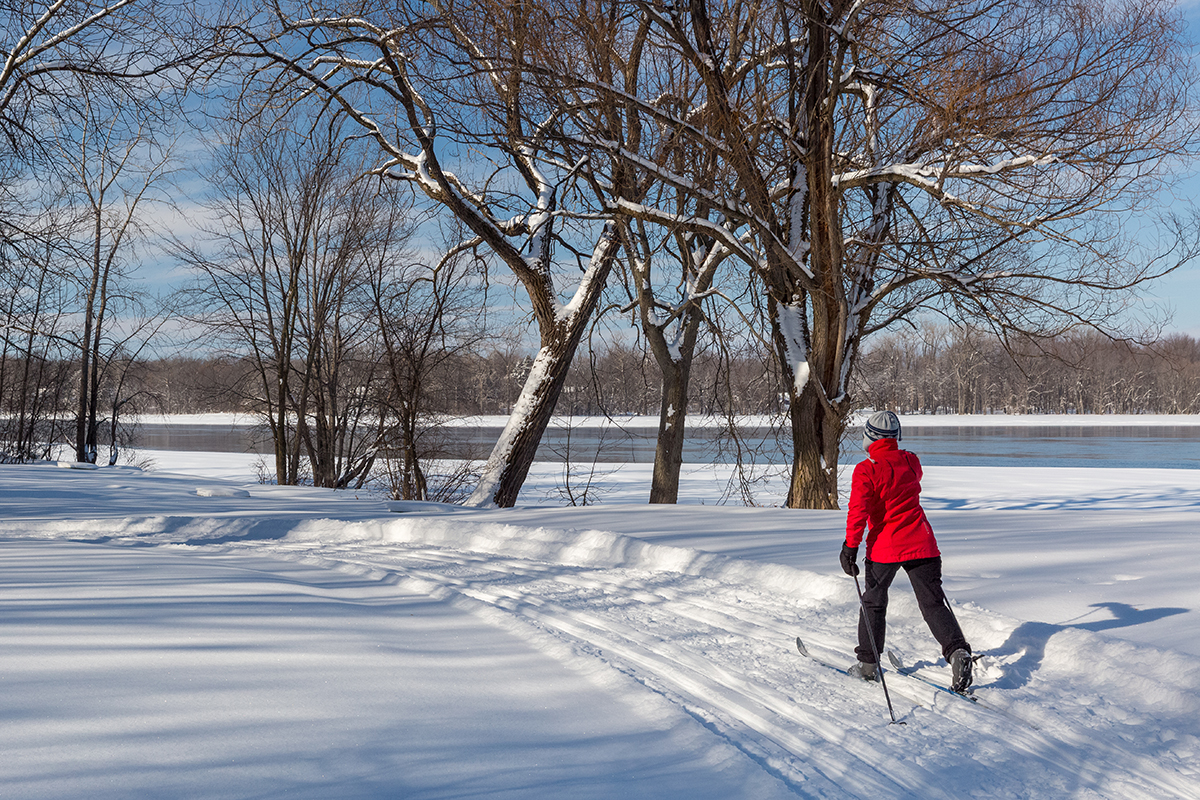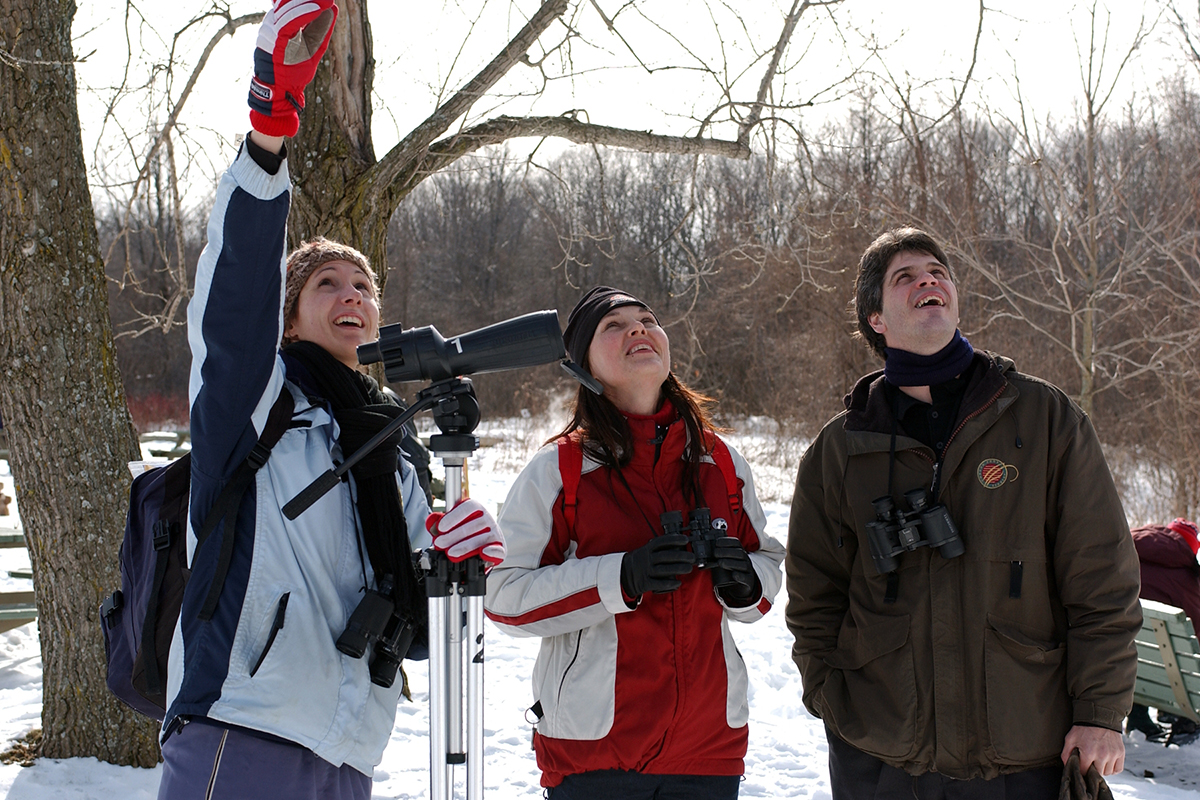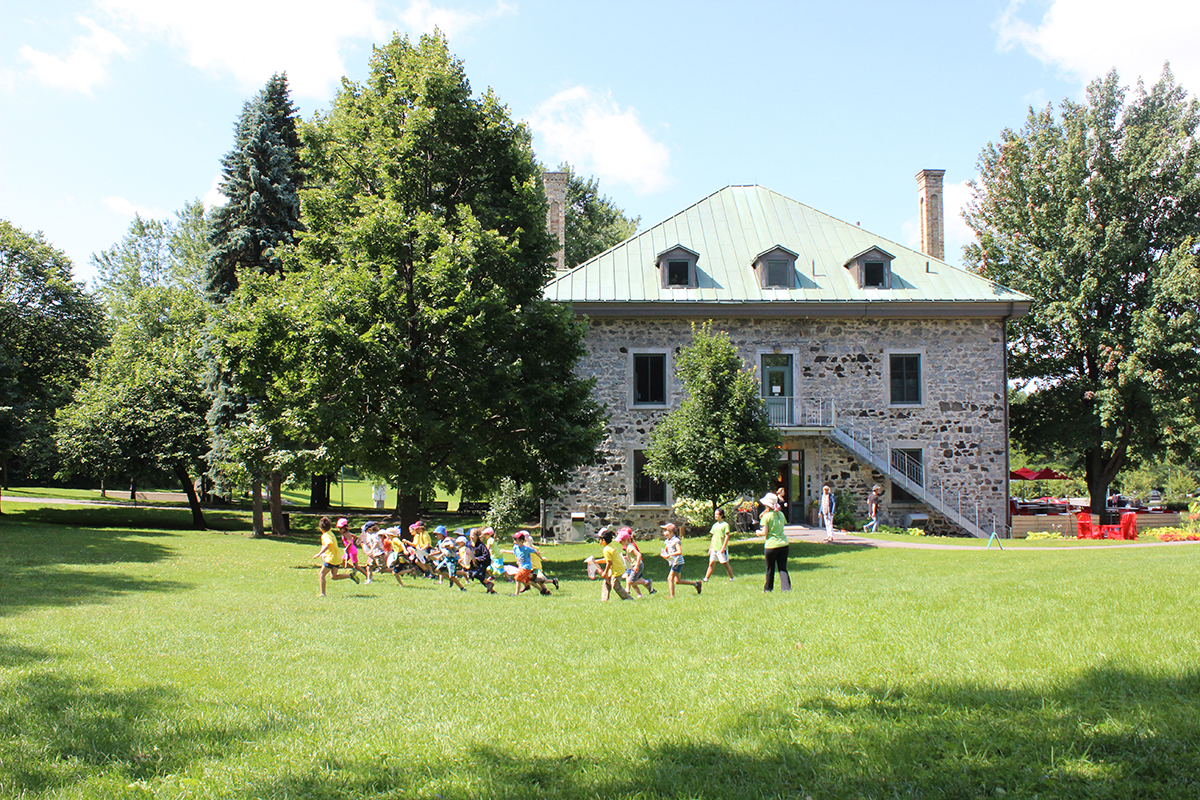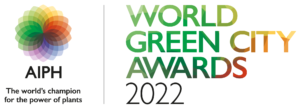Addressing the urban challenge
Breadth of the issue – How are the problem(s) that are being tackled by your initiative affecting citizens/local businesses or a significant component of the local wildlife?
The Nature and Sports Plan’s actions span the entire Montréal Urban Agglomeration (MUA). Vulnerability analysis undertaken by Montréal’s Ecological Transition and Resilience Bureau identified important zones vulnerable to climate hazards: higher average temperatures, heavy rainfalls, destructive storms, droughts, and river floods. The Plan’s aim to preserve and enhance nature constitutes a major adaptation measure to reduce Montréal’s vulnerabilities. Vegetation is especially important to fight against urban heat island effects, to purify the air, to contribute to water management, to limit flood damage and to prevent erosion, among others.
Montréal aims to protect 10% of the MUA’s inland area to preserve natural areas – refuges for biodiversity – and integrate them into the large parks network to ensure long-term conservation and public access. The City is currently planning the enhancement of existing parks, and the development of new parks, for example, the future Grand parc de l’Ouest in the vast and richly biodiverse western part of Montréal, the future Pôle nature de l’Est, in a part of Montréal characterized by urbanization, industrial activities and the presence of remaining natural spaces, and the future Lachine waterfront park, in the southern part of Montréal, on a site previously harbouring a private marina which will be transformed into a public park on the shores of Lake Saint-Louis.
Through the Nature and Sports Plan, the city also intervenes in urbanized areas, which cover most of Montréal’s territory, by increasing and strengthening the urban forest, developing a network of green corridors, and creating green public spaces.
Depth of the issue – How seriously are the problems being tackled by your initiative impacting the life of the citizens/businesses/wildlife concerned?
Citizens’ physical and mental health are closely linked to the presence of nature in cities. Parks offer attractive places for outdoor activities, relaxation, and reinvigorating body and mind. During the last three years, marked by COVID-19, public visits to Montréal’s large parks have increased by 129%, a testimony to their importance, especially in a time of heightened collective and individual stress. Greener cities are also attractive places for tourism and investment. Families, students, and businesses are looking for places offering a high-quality lifestyle.
Massive tree planting has a concrete effect on health and quality of life, bringing shade and better air quality to neighbourhoods on hot and smoggy days, and improving well-being. Sectors vulnerable to heat are prioritized, as extreme heat will become more prevalent in the context of climate change.
Some northern residential sectors, on the shores of the Des Prairies River, suffered major flood damage in spring 2017. Restoration of wetlands, waterways, and shorelines, a major objective of the Plan, will contribute to fostering collective resilience and a sense of security. Ecological restoration of shorelines will contribute to fighting erosion and protecting infrastructures.
Finally, actions aimed at protecting ecosystems have very concrete impacts on our natural heritage. Large parks are home to a major part of Montréal’s biodiversity. We carefully monitor species at risk through our inventories and interventions (e.g., habitat management). We also collaborate on larger-scale conservation initiatives such as the provincial northern map turtle recovery plan.
The power of plants and natural ecosystems to deliver benefits
How is the initiative shaped by scientific evidence of the potential for plants and natural ecosystems to deliver benefits?
Studies on urban ecosystem services demonstrate the wide array of environmental, social, health-related and economic advantages that nature brings to the population. Québec’s national public health institute (INSPQ) published a literature review in 2017 on the importance of greening cities: urban green spaces provide great opportunities for physical activity and are linked to the reduction of stress and symptoms of depression, and the reduction of mortality associated with certain diseases. Moreover, studies demonstrated that a mature tree could provide daily oxygen intake for four people and capture up to 20 kg of airborne particles per year. The Nature and Sports Plan will boost nature’s benefits for Montrealers through the enhancement of, and increased accessibility to, urban nature, parks, and recreational and sporting activities.
The Plan includes Ecosystem Management to preserve a lasting balance between the protection of environmental integrity and public access to large parks. This approach was conceived in 1995 by the City of Montréal in collaboration with Université de Montréal’s Institute de recherche en biologie végétale (plant biology research centre). It is built around knowledge acquisition (wildlife inventories), ecological evaluation, monitoring of ecosystems, and interventions to preserve biodiversity.
In 2020, the Université du Québec à Montréal, with the City’s support, created the Centre for Forest Research. This centre collaborates with the City to study the urban forest in view of adapting to climate change and ensuring resilience and the continued provision of quality ecosystem services, especially to vulnerable populations.
How has the city exploited the potential of plants and associated ecosystems to deliver more than one benefit?
Montréal hosts some twenty large parks. Nature parks, whose main vocation is conservation, are home to a variety of natural habitats, and to numerous flora and fauna species. Aside from reception buildings, developments are usually limited to nature trails and structures like wildlife observatories. Natural habitats are protected, preserving their maximum potential for ecosystem services, including regulation services (air purification, erosion prevention, pollination, etc.), cultural services (aesthetics, mental well-being, artistic inspiration, etc.) and support services (refuge for at-risk species, maintenance of genetic diversity, soil formation, etc.). Some provisioning services are possible (e.g., fishery) but extraction is usually prohibited in nature parks. Not-for-profit partner organizations offer popular nature interpretation activities, providing environmental education and fostering a sense of belonging. They also provide equipment rental services for citizens (cross-country skis, snowshoes, etc.). Other of our large parks host natural areas that are subject to ecosystem management, but also wide grassed landscaped areas and spaces for group sporting activities, enabling services like recreation and social cohesion.
Actions deriving from The Nature and Sports Plan also take place outside of large parks, like planting trees in neighbourhoods and creating green public places in downtown areas. Demineralizing and adding vegetation to mineralized heat island areas bring significant benefits, notably cooler temperatures, water retention, improved aesthetics, and contact with nature. When greening public spaces, we look to increase ecological resilience through techniques that favour plant diversity, soil permeability, water retention, habitat creation, etc.
Innovative and Collaborative Solution
How does the initiative show evidence of feasibility, including on-going financial and logistical support?
The Large Parks, Mont-Royal and Sports Department’s ten-year financial planning entirely supports The Nature and Sports Plan. The next ten-year capital plan will allocate $1,975 million to materialize the Plan. We can also count on substantial financial support from other levels of government, which provides leverage to accelerate public investments and achieve The Nature and Sports Plan’s goals.
Current allocations include $281 million to strengthen the urban forest, $168 million to the acquisition of natural areas, $102 million to rehabilitating shorelines, $62 million to developing the parc-nature de l’écoterritoire de la falaise, and $54 million to the development of the Grand parc de l’Ouest, among others.
In what ways is the initiative innovative?
In the past decade, Montréal has experienced the rapid spread of the emerald ash borer, an exotic insect species that kills ash trees. In some large parks, high levels of mortality in ash-dominated stands have created favourable growing conditions for an exotic invasive plant species, the European buckthorn. The combined effect of these two very invasive species – an insect and a plant – represents a significant threat to the functions and biodiversity of forest ecosystems and poses a complex challenge. To restore ecosystems following ash tree felling, soil surface is mechanically ground to fight against the buckthorn, and replacement indigenous trees and shrubs, characteristic of the forest, are planted right away, to prevent invasion and foster forest resilience.
Wood from locally felled ash trees is reused and transformed into furniture such as park benches, giving it a second life and returning it to the community. This is being done through a partnership with not-for-profit organizations Bois public and Centre de valorisation du bois urbain.
A new dedicated expert team was created to achieve The Nature and Sports Plan’s goal of rehabilitating shorelines in large parks. Two biologist planning advisors, two landscape architects, a technical officer specialized in natural habitats protection, an engineer and a project management specialist were hired to this end. Cutting-edge phytotechnology will be a featured solution. Various techniques are under consideration to stabilize and restore riverbanks, like slope remodelling and plantation, use of live stakes, vegetated geogrids, and root wads, etc.
How is the initiative supported by collaborative working across disciplines and sectors?
The Nature and Sports Plan is implemented by the Large Parks, Mont-Royal and Sports department, which employs a variety of experts: planning advisors (biologists, sociologists, urban planners, etc.), forest engineers, landscape architects, engineers, development officers, horticulturists, project controllers, research assistants, and geomatics specialists, among others. The Plan’s wide range of initiatives requires interdisciplinary perspectives and collaboration with experts from other city departments, including Urban Planning and Mobility, Ecological Transition and Resilience, Space for Life (scientific museum institutions), Property Planning and Management, Road Infrastructures, Diversity and Inclusion, Culture, Citizen Experience and Communications, Economic Development, Municipal and Governmental Relations, and International Relations, as well as local experts from Montréal’s boroughs, who have acute awareness of local issues and community needs.
Collaboration also occurs with external partners, such as architectural consultancy groups, designers, public consultation specialists, the governments of Canada and Québec, research centres like Université de Montréal’s Institut de recherche en biologie végétale and Université du Québec à Montréal’s Centre for Forest Research, and several not-for-profit (NPO) organizations. Some NPOs offer natural and cultural interpretation activities to the public in large parks. Other NPOs plant trees on private and institutional lands, thus increasing Montréal’s urban forest and tree canopy. In the Cap-Saint-Jacques sector, NPOs operate a social and circular economy project, cultivating organic vegetables on City-owned agricultural lands and distributing them free-of-charge to local food banks.
How does the initiative demonstrate evidence of community support?
Montréal has extensive experience in public consultation, and Montrealers have demonstrated time and time again their attachment to their natural environment. In 2020, the city launched an online public consultation regarding the future Grand parc de l’Ouest. Citizens were invited to share their ideas to foster a collective vision for this new park. More than 20,000 page visits were recorded. Respect for nature and accessibility came out as the values of highest importance. A vast concertation process, involving citizens, NGOs, indigenous communities, landowners, government partners and other stakeholders, is now being planned and will be deployed in the upcoming months and years.
The development of the future parc-nature de l’écoterritoire de la falaise was also submitted to consultation, this time, through the Office de consultation publique de Montréal (OCPM), an independent body whose mission is to undertake public consultation mandates entrusted to it by the city. The OCPM’s 2019 report underlines how this ambitious project to transform a highly mineralized and inaccessible area into a nature park has received almost unanimous support.
Local community organizations are involved, notably in urban reforestation efforts. The City plants trees on Montréal’s municipal property and contributes financially to the work of the Alliance forêt urbaine (AFU), a group of 50 organizations that plants trees on private and institutional lands. Headed by the not-for-profit organization SOVERDI, the AFU coordinates plantings and distributes funds to local organizations that want to carry out a tree planting project.
Implementation, Impact and Replicability
How does the initiative demonstrate evidence of a track record of success against pursued objectives?
One of the main advances to date is the creation of the Grand parc de l’Ouest. Encompassing an area of more than 3,000 ha, this future park could become Canada’s largest municipal park. A public consultation was held in 2020 to identify a collective vision for the park.
Montréal is working hard to protect more spaces of interest for biodiversity to reach our goal of protecting 10% of the agglomeration’s inland territory. An innovative avenue explored was the creation of a “man-made landscape” in the western portion of L’Île-Bizard island. This type of protected area allows some human activities compatible with the conservation of biodiversity to be carried out. The Paysage humanisé projeté de L’Île-Bizard aims to preserve and enhance ecological connectivity, biodiversity and associated ecosystem services, to preserve and enhance hedgerow farming as a practice that contributes to the landscape’s distinctiveness and biodiversity, and to ensure the sustainable use of biodiversity and renewable natural resources. It became Québec’s first “man-made landscape” (category V in the IUCN protected area system) after its status came into effect on September 30th, 2021. With this innovative project, our percentage of protected inland territory increases by approximately 2%.
A new dedicated expert team was set up in 2021 to rehabilitate shorelines in the large parks. Seven specialists were hired for the team and have begun working on the characterization and assessment of 26 km of public shores to prioritize restoration and landscape interventions.
How has the initiative had a ripple effect beyond the scope of the initiative itself, thereby demonstrating a change in the city’s and/or its partners’ way of working with plants?
The recently hired team in charge of shoreline rehabilitation projects will be able over time to provide expertise and support boroughs that are highly impacted by floods, which are becoming more and more frequent. The Large Parks, Mont-Royal and Sports department is already being asked to advise and guide boroughs and other departments on how to protect and increase biodiversity (for example, through conservation of threatened species, ecosystem management, restoration and compensation, and compliance with environmental regulations).
Considering all the benefits provided by trees, we see trees more as an investment than an expense. The city is involved in discussions with other Canadian cities and various organizations to explore the possibility of having trees recognized as capitalizable infrastructure in the same way as other urban infrastructure. This would make it easier to fund tree plantings with capital expenditure budgets and not just through limited operating budgets.
Balancing ecological integrity and public access in parks became an even more significant issue during the pandemic as park frequentation strongly increased. In 2020, the city launched an awareness campaign to encourage good behaviours in large parks in order to preserve our natural heritage, which is a collective responsibility. Topics addressed include the importance of staying on trails; of keeping pets on a leash; of not feeding wild animals, picking up plants, or dumping garden waste. Parc du Mont-Royal, located in the heart of the city, is especially popular and much effort was focused on this site.
How have other cities expressed interest in the initiative, or what potential does it have to interest other cities and be customised to their own circumstances?
Our urban forest management team made contact with other North American cities that were faced with the invasion of the emerald ash borer, to exchange experiences and build on them to develop our own strategy. Some of these cities had seen all street trees disappear in residential sectors. In recent years, our experts were called upon to share their own expertise with other cities in the provinces of Québec and Ontario. Montréal’s approach is to conserve significant ash trees and replace dying ash trees, while planting 500,000 trees of various species, to restore ecosystem services and simultaneously make the urban forest more resilient to future threats in the context of climate change.
In 2019, the Mayor of Montréal was appointed ICLEI Global Ambassador for Local Biodiversity, and the City joined ICLEI’s CitiesWithNature network to connect, learn, exchange, and inspire. In 2020, in collaboration with ICLEI, CitiesWithNature, and the Secretariat of the Convention on Biological Diversity, Montréal produced and shared information sheets on six concrete actions taken to protect natural heritage. These relate specifically to ecosystem management, coexistence with coyotes, conservation of wildlife trees, environmental action days, renewed and improved wildlife observatories, and wildlife passages in the urban environment, actions that fall within larger goals and programs within The Nature and Sports Plan. The aim was to share information on municipal biodiversity-friendly initiatives, to provide advice to facilitate reproducibility in other cities and inspire, and to identify the global biodiversity objectives to which the local initiative contributes.
Sustainability and Resilience
What efforts have been made to reduce the carbon footprint of the initiative?
The Nature and Sports Plan is aligned with strategic objectives set forth in the Montréal 2030 Strategic Plan, aiming to make Montréal a resilient city that is engaged in ecological resilience, fosters solidarity and inclusiveness, and encourages participation and innovation. The Nature and Sports Plan contributes to putting Montréal 2030’s “Accelerate the ecological transition” ambition into action. Three of our objectives are included in the City’s Climate Plan, recognizing their importance on that front: protecting 10% of Montréal’s terrestrial area, planting and maintaining 500,000 trees (especially in areas that are vulnerable to heat waves), and restoring riparian areas in large parks.
In forested areas where ash trees killed by the emerald ash borer have been felled to ensure hikers’ safety, wood is recovered and takes on a second life, through a partnership with not-for-profit organizations. Large ash trees are cut into boards after removing any part infested with emerald ash borer larvae. Ash boards and mouldings are used by boroughs and related cities of the Montréal agglomeration to renovate buildings and build indoor and outdoor furniture such as benches. Small diameter ash trees are crushed on site to remove all traces of the emerald ash borer, and the chips are used to amend the soil.
Sustainability is an important aspect of the Active Montréal component of The Nature and Sports Plan. Among other objectives, it aims to increase the number of environmentally responsible sporting events, notably through the establishment of sustainability and environmental responsibility standards for large-scale sporting events.
How have the anticipated impacts of climate change been considered?
A reliable supply of new quality trees is essential to maintain the pace of planting. Due to the devastation of ash trees by the emerald ash borer in Québec, Ontario, and the United States, obtaining tree supplies for certain species is expected to become increasingly difficult, and this could affect biodiversity. Fortunately, Montréal owns a tree nursery that provides approximately 30% of the city’s tree needs per year. To remedy this future scarcity and ensure the diversity of plantations, the nursery has been given the mandate to produce species that explicitly meet the needs of Montréal’s boroughs. Production has thus greatly diversified over the years while selecting the most suitable species and cultivars. Today, the nursery is producing no less than 178 species and varieties representing 33 different tree genera. Efforts are also being made to select tree species that will resist future growing conditions linked to climate change.
Montréal’s tree planting strategy on streets and in local parks also applies the functional groups approach, recently developed by a Université du Québec à Montréal research group: to ensure resilience, a group of trees should comprise species that have different functional traits (tolerance to strong winds, to drought, to flooding, to intense cold, to heat, etc.). Tree planting conditions in highly urbanized areas have been enhanced to better meet tree survival and growing requirements. Since 2019, the City’s standardized infrastructure specifications include enlarged tree pits that extend under a structural sidewalk and allow for greater volumes of soil.
What processes does the initiative include for it to be considerate in its use of soils and other natural resources?
In natural areas, we only plant indigenous species, which are known to be better adapted to Montréal’s environmental conditions and require less maintenance. For the felling of trees in natural areas, City crews use proven felling methods that minimize the impact on natural environments. For example, all felling in these areas is carried out during winter when the ground is frozen and uses small machinery to limit soil compaction.
At Montréal’s municipal tree nursery, to the extent allowed by regulations and favourable climatic conditions, watering uses water from a nearby river instead of the potable municipal network. Organic matter from local and regional sources as well as green manure are used to conserve and regenerate soils.
As mentioned, we apply the principle of “the right tree in the right place”, planting trees in the appropriate place, based on their characteristics and tolerance to stressors. Furthermore, for tree pits adjacent to the street, a standardized technical approach steers rainwater towards trees in order to better manage water, supply trees and reduce tank-truck watering. A pilot project is being set up to assess the impacts of contaminants, especially de-icing salts, on tree health, and to find solutions if required.
Monitoring, Maintenance, and Management
How has the initiative been designed and implemented so that long-term needs for management and maintenance are reduced and can be met?
A third of the trees planted in Montréal are being grown and prepared in our municipal tree nursery. Trees are selected for their desired characteristics: hardiness, tolerance to urban conditions, visual appeal, etc. We pursue the principle of “the right tree in the right place”. Trees most tolerant to urban stressors might be planted on a commercial street, while trees that are less tolerant, need more root space and higher soil quality, for example, might be planted in a local park. High levels of maintenance and replacement of unsuccessful plantings are costly in environmental and financial terms, including human resources. Favouring “the right tree in the right place” is therefore exponentially beneficial. As also mentioned, tree planting conditions in highly urbanized areas have been enhanced to better meet tree survival and growth requirements. Since 2019, the City’s standardized infrastructure specifications include enlarged tree pits that extend under a structural sidewalk and allow for greater volumes of soil.
In natural areas within large parks, an ecosystem management program has been implemented for over 25 years. It monitors ecosystems and biodiversity to ensure the sustainability of these natural infrastructures for current and future generations of Montrealers.
Construction and renovation of buildings or structures within large parks also take into account sustainability principles. For example, construction materials used in the redevelopment of wildlife observatories were selected based on principles of sustainable development.
What protocols are in place to facilitate monitoring of results?
Fifty-eight indicators have been identified to monitor The Nature and Sports Plan’s results throughout the years. These include (but are not limited to): the percentage of protected areas, the canopy index, the global tree increase, the total length of rehabilitated shorelines, the number of projects that restore ecological functions of degraded wetlands, the number of projects allowing for visual or physical access to water, the total area subject to invasive plant species management, the diversity of flora and fauna species maintained in large parks, the percentage of inclusive activities and services in large parks, the number of actions enabling increased access to exceptional sites on Mont-Royal, the number of people reached by environmental awareness campaigns in parc du Mont-Royal, the investments in sports programmes per boroughs, and the number of people with disabilities who participate in sporting activities.
It is worth noting that the percentage of protected areas (target of 10%), and the number of trees planted (target of 500,000) are also indicators of Montréal’s Climate Plan.
How has the initiative been enhanced in response to monitoring of results?
The Nature and Sports Plan presents our strategic orientations, our main goals, and our major projects to be implemented in the next ten years, and it is supported by solid financial planning. The Plan is not static, it is a dynamic tool that allows for new projects to be integrated, in order to achieve our ambitions, and to go even further in protecting our natural heritage, enhancing our large parks network, and promoting a healthy and active lifestyle. The continued monitoring of our 58 indicators, our specialists and partners’ expertise and experiences on the field, as well as new opportunities that might arise (for park enhancement or increased accessibility, for example), will inform planning and implementation of the Nature and Sports Plan.
It is worth noting that monitoring is already an integral part of the ecosystem management undertaken in our large parks network. Knowledge of ecosystems, acquired through inventories and ecological evaluations, is the basis of our actions. We monitor ecosystems and are therefore able to adjust and intervene when necessary to improve habitat resilience and biodiversity (invasive species management and protection of species at risk are good examples).


















